Throughout American history, dominant groups have strived to oppress other subcultures. For example, after the passing of the 19th amendment that gave women the right to vote, an entirely male run government made efforts to invoke cultural restrictions upon women, similar to how culture further oppressed African Americans upon receiving citizenship. The reaction to the increase in rights for women and African Americans prompted men to degrade these marginalized groups through the use of new media techniques. The idea that women would have the legal ability to influence political power and legislation forced men to assert their rights, thus keeping women “under their belts.” One way in which media brought about imagery and slogans to increase power was through the simplification of women presented in alcohol advertisements. These articles demonstrated how alcohol could help men reclaim their power over women. Although society has since evolved to allow men and women to have a more equal opportunity, both professionally and socially, media advertisements for alcoholic beverages have continued to degrade women and encourage sexism.
One example of the sexism present in alcohol advertisements is in the Svedka ad above. This vodka brand advertises that women are expendable, implying that the perfect wife would be a trophy wife and portrays the ideal woman as being one with the “perfect form.” According to Svedka, this is a small waisted woman with long legs and wide hips. Not only is the ad sexist, but it also subjects women to desire the perfect form as depicted here. This leaves women feeling insecure for not having it; magazine ads featuring "perfect" women have the same effect. The majority of Jose Cuero ads feature women in bikinis, and all imply sex with women through their slogans: “Bad girls make good company,” “Seize the day…and the night!” and “Pursue your daydreams.” All of the ads from Jose Cuervo promise sex with women if a man drinks their tequila. They have created the illusion via advertising, that alcohol allows men to have power over women. Regardless of women’s involvement in the physical ad, alcohol is always advertised as a man’s drink.
While society has evolved to create more equal opportunities for women and men, women are still used as a gimmick for luring men into purchasing alcohol. Sexism in alcohol advertisements, has been a persistent problem. As seen in the Budweiser ads, alcohol is still marketed as a tool to help men restrain women. This strategy also applies to the lack of alcoholic beverages and advertisements marketed to women.
Finally, there is a brand of alcohol that has been created for women called Skinny Girl. Although it is not ideal as it is a diet program now offering low-calorie cocktails for women and thus promoting the ideal image. It is a physical representation of the progress towards equality. This advertisement for Skinny Girl show that the “strictly for men” image is being torn down. With more females in the work force and with more men taking traditional female roles in the household, as stay-at-home dads, society is evolving. Companies that produce alcohol are gradually making a change in order to market towards women, in addition to men, and change alcohol’s identity to be a drink for both men and women.

























